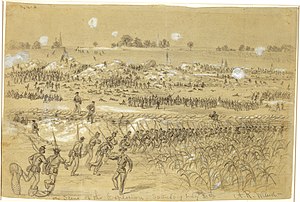
Back معركة الحفرة Arabic Kraterschlacht German Batalla del Cráter Spanish Kraterraren gudua Basque Bataille du Cratère French Battaglia del cratere Italian クレーターの戦い Japanese Slag van de Krater Dutch Bitwa o krater Polish Batalha da Cratera Portuguese
| Battle of the Crater | |||||||
|---|---|---|---|---|---|---|---|
| Part of the American Civil War | |||||||
 Scene of the explosion July 30th 1864 Alfred R. Waud, artist | |||||||
| |||||||
| Belligerents | |||||||
|
|
| ||||||
| Commanders and leaders | |||||||
|
|
| ||||||
| Units involved | |||||||
|
| Elements of the Army of Northern Virginia | ||||||
| Strength | |||||||
| 8,500[2] | 6,100[2] | ||||||
| Casualties and losses | |||||||
|
3,798 total 504 killed 1,881 wounded 1,413 missing or captured[3] |
1,491 361 killed 727 wounded 403 missing or captured[3] | ||||||
Location within Virginia | |||||||
The Battle of the Crater took place during the American Civil War, part of the Siege of Petersburg. It occurred on Saturday, July 30, 1864, between the Confederate Army of Northern Virginia, commanded by General Robert E. Lee, and the Union Army of the Potomac, commanded by Major General George G. Meade (under the direct supervision of the general-in-chief, Lieutenant General Ulysses S. Grant).
After weeks of preparation, on July 30 Union forces exploded a mine across from Union Major General Ambrose E. Burnside's IX Corps sector, blowing a gap in the Confederate defenses of Petersburg, Virginia. Instead of being a decisive advantage to the Union, this precipitated a rapid deterioration in the Union position. Unit after unit charged into and around the crater, where most of the soldiers milled in confusion in the bottom of the crater. Grant considered this failed assault as "the saddest affair I have witnessed in this war."[4]
The Confederates quickly recovered, and launched several counterattacks led by Brigadier General William Mahone. The breach was sealed off, and the Union forces were repulsed with severe casualties, while Brigadier General Edward Ferrero's division of black soldiers was badly mauled. It may have been Grant's best chance to end the siege of Petersburg; instead, the soldiers settled in for another eight months of trench warfare.
Burnside was relieved of command for his role in the fiasco, and he was never returned to command,[1] while Ferrero and General James H. Ledlie were observed behind the lines in a bunker, drinking liquor throughout the battle: Ledlie was criticized by a court of inquiry into his conduct that September, and in December he was effectively dismissed from the Army by Meade on orders from Grant, formally resigning his commission on January 23, 1865.
- ^ a b "NPS". Archived from the original on September 9, 2005.
- ^ a b Cite error: The named reference
cwsacwas invoked but never defined (see the help page). - ^ a b Cite error: The named reference
casualtieswas invoked but never defined (see the help page). - ^ The Papers of Ulysses S Grant, Vol. 11, p. 362
© MMXXIII Rich X Search. We shall prevail. All rights reserved. Rich X Search
